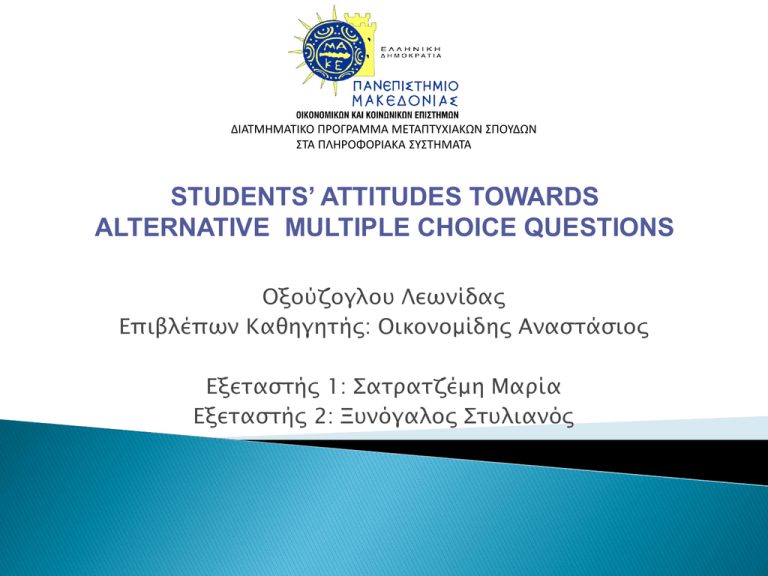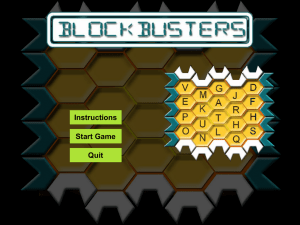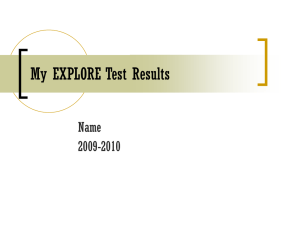Oxouzoglou_Leonidas
advertisement

ΔΙΑΤΜΗΜΑΤΙΚΟ ΠΡΟΓΡΑΜΜΑ ΜΕΤΑΠΤΥΧΙΑΚΩΝ ΣΠΟΥΔΩΝ ΣΤΑ ΠΛΗΡΟΦΟΡΙΑΚΑ ΣΥΣΤΗΜΑΤΑ STUDENTS’ ATTITUDES TOWARDS ALTERNATIVE MULTIPLE CHOICE QUESTIONS Οξούζογλου Λεωνίδας Επιβλέπων Καθηγητής: Οικονομίδης Αναστάσιος Εξεταστής 1: Σατρατζέμη Μαρία Εξεταστής 2: Ξυνόγαλος Στυλιανός objective easy to score cost-effective (especially in large scale assessment) sampling of content can be broader items can be stored in item-banks and reused the use of large number of items is possible individual test items can be subjected to statistical analysis more difficult to construct when used for assessing higher levels, the reliability is questioned the examinee might be exposed to acquiring false knowledge the score might be affected by the use of guessing lack of assessment of partial knowledge Developed to address the problem of guessing and to assess partial knowledge the scoring of a test just by counting the number of correct answers if a wrong option is chosen, the score of the item is 0 Scoring Rule where k, the number of choices in an item •the examinee, in case of an incorrect choice, is permitted to choose one of the remaining options. •this procedure is repeated until the correct option is selected. Scoring Rule S(k,a) = k – a where k is the number of choices in an item and a is the number of attempts (Coombs et al., 1956) the student has to indicate the wrong options of an item Scoring Rule for MCQs with 4 options the examinee is permitted to choose more than one options General Scoring Rule: the larger the number of options selected the lesser the score credited to the item Liberal Tests (Bush ,2001) where k is the number of options in a MCQ and a is the number of options selected by the examinee Zeidner (1990) the majority of students believe that essay type exams are: • more reflective of students' true achievements, •more suitable for assessing course objectives, •generally fairer than MCQs students find MCQ type exams : •easier and less time consuming to prepare for •feel less time-pressure when taking the exams Birenbaum & Feldman (1998) •students with good learning skills who have high confidence in their academic ability, tend to prefer the constructed-response type of assessment over the MCQ type •students with high test-anxiety tend to prefer the MCQ testing format Birenbaum (1997); Furnham et al. (2008); Gijbels & Dochy (2006) students’ approaches to learning have a significant effect on assessment preference •what are the students’ preferences and opinions regarding assessment using MCQs ? •how do factors like gender, grade of education, school performance and course preference affect students’ preference in a certain method ? •what is the relation, if any, of student’s preference in an assessment method and his/her approach to learning ? Participants: 178 students from the area of Thessaloniki •96 students of secondary education •82 university students Participants: 178 students from the area of Thessaloniki •100 females • 78 males Questionnaires : •Revised two-factor learning process questionnaire (R-LPQ-2F, Kember et al., 2004) •Revised two-factor study process questionnaire (R-SPQ-2F, Biggs et al., 2001) Questionnaires : Preferred Assessment Method Methods of Assessment •Essay type questions. •Number of Right (NR). •Negative Marking (NM) •Answer Until Correct (AUC). •Elimination Testing (ET) •Subset Selection Testing (SST) Questionnaires : Preferred Assessment Method •Indicate how fair you think is this method. •Indicate how accurate you think is this method in measuring each person’s level of knowledge. •Indicate how stressful for the student you think this method is. •Indicate the level of your personal preference in this method. (9-point Likert – type scale) Procedure: •The students were given the questionnaires in class, under test conditions and given adequate time to think and respond. •The assessment methods had been thoroughly explained to them in a previous meeting. •A written explanation of the methods was given to them along with the questionnaires. •Correlations between perceived fairness and level of preference were positive and significant at the 0.01 level •Correlations between perceived accuracy and level of preference were also positive and significant at the 0.01 level •Correlations between perceived student anxiety and level of preference were negative and not all of them significant •Correlations between perceived fairness and perceived accuracy were computed and found to be positive and significant at the 0.01 level Level of Perceived Preference Fairness Method of Assessment Essay Type Number of Right Negative Marking Answer Until Correct Elimination Testing Subset Selection Testing Perceived Accuracy Perceived Student Anxiety Mean 5.41 5.83 6.78 6.55 SD 2.596 2.342 2.207 2.456 Mean 6.21 5.97 5.80 4.98 SD 2.115 2.105 2.108 2.052 Mean 3.20 3.50 4.47 6.73 SD 2.195 2.391 2.410 2.095 Mean 4.85 4.68 3.86 4.06 SD 2.382 2.492 2.291 2.161 Mean 5.03 5.34 4.91 4.47 SD 2.231 2.086 2.043 2.174 Mean 5.01 4.76 4.57 4.90 SD 2.669 2.692 2.506 2.370 Correlations between Level of Preference in different methods Essay Type Level of Preference Essay Type Level Pearson Correlation of Preference NR Level of Preference NM Level of Preference AUC Level of Preference ET Level of Preference SST Level of Preference 1 Sig. (2-tailed) NR Level of Preference NM Level of Preference Pearson Correlation ,036 Sig. (2-tailed) ,631 Pearson Correlation Sig. (2-tailed) AUC Level of Preference Pearson Correlation Sig. (2-tailed) ET Level of Preference Pearson Correlation Sig. (2-tailed) SST Level of Preference Pearson Correlation Sig. (2-tailed) 1 -,067 ,027 1 ,373 ,721 -,310** -,025 ,150* ,000 ,740 ,047 -,275** -,104 ,093 ,451** ,000 ,168 ,215 ,000 -,158* -,143 ,171* ,200** ,290** ,036 ,057 ,022 ,008 ,000 1 1 1 Grade Secondary University Standard Mean Deviation Standard Mean Deviation Essay Type Level of Preference 5,22 2,653 5,63 2,526 NR Level of Preference * 5,86 2,019 6,62 2,165 NM Level of Preference 3,19 2,168 3,22 2,239 AUC Level of Preference 4,92 2,199 4,77 2,595 ET Level of Preference 5,14 2,208 4,90 2,264 SST Level of Preference 5,32 2,618 4,63 2,697 * the difference of mean values is significant at the 0.05 level Level of Preference categorized by grade of education Correlations between Level of Preference in each method and learning approach scale scores Essay Type NR Level NM Level AUC ET Level SST Level Level of of of Level of of of Preference Preference Preference Preference Preference Preference Deep Aproach Pearson Correlation Scale Score (%) Sig. (2-tailed) Pearson Surface Aproach Scale Correlation Score (%) Sig. (2-tailed) ,185* ,190* ,026 -,033 ,048 ,122 ,013 ,011 ,730 ,661 ,524 ,106 -,071 -,212** -,074 ,094 ,004 ,186* ,343 ,005 ,327 ,214 ,961 ,013 ANOVA analysis significant interactions between: Learning Approach and Gender factors in Level of Preference in Essay Type (significant at the 0.01 level) and SST (significant at the 0.05 level). ANOVA analysis Tests of Between-Subjects Effects Dependent Variable: Essay Type Level of Preference Source Type III Sum of Squares df Mean Square F Sig. 62,678a 3 4727,720 1 23,334 1 23,334 3,592 ,060 ,024 1 ,024 ,004 ,952 44,067 1 44,067 6,783 ,010 Error 1130,384 174 6,496 Total 6403,000 178 Corrected Total 1193,062 177 Corrected Model Intercept LearnApp Gender LearnApp * Gender 20,893 Level of Preference in Essay Type 3,216 ,024 4727,720 727,738 ,000 Learning Approach * Gender Dependent Variable: Essay Type Level of Preference 95% Confidence Interval a. R Squared =,053 (Adjusted R Squared =,036) Learning Std. Gender Mean Approach Error DA SA Lower Bound Upper Bound Female 5,172 ,335 4,512 5,833 Male 6,224 ,364 5,506 6,943 Female 5,452 ,393 4,676 6,229 Male ,473 3,514 5,382 4,448 ANOVA analysis Tests of Between-Subjects Effects Dependent Variable: SST Level of Preference Source Type III Sum of Squares df Mean Square F Sig. 58,686a 3 4382,715 1 30,748 1 30,748 4,450 ,036 6,103 1 6,103 ,883 ,349 35,253 1 35,253 5,102 ,025 Error 1202,309 174 6,910 Total 5721,000 178 Corrected Total 1260,994 177 Corrected Model Intercept LearnApp Gender LearnApp * Gender 19,562 Level of Preference in SST 2,831 ,040 4382,715 634,273 ,000 Learning Approach * Gender Dependent Variable: SST Level of Preference 95% Confidence Interval a. R Squared =,047 (Adjusted R Squared =,030) Learning Std. Gender Mean Approach Error DA SA Lower Bound Upper Bound Female 4,966 ,345 4,284 5,647 Male 4,429 ,376 3,687 5,170 Female 4,905 ,406 4,104 5,705 Male ,488 5,243 7,170 6,207 ANOVA analysis significant interactions between: Learning Approach and Grade factors in Level of Preference in SST (significant at the 0.05 level). ANOVA analysis Tests of Between-Subjects Effects Dependent Variable: SST Level of Preference Source Type III Sum of Squares Df Mean Square F Sig. 57,943a 3 2987,353 1 1,693 1 1,693 ,245 ,621 Grade 21,237 1 21,237 3,072 ,081 LearnApp * Grade 27,445 1 27,445 3,969 ,048 Error 1203,052 174 6,914 Total 5721,000 178 Corrected Total 1260,994 177 Corrected Model Intercept LearnApp 19,314 Level of Preference in SST 2,793 ,042 2987,353 432,067 ,000 Learning Approach * Grade Dependent Variable: SST Level of Preference 95% Confidence Interval a. R Squared =,046 (Adjusted R Squared =,030) Learning Approach Grade DA SA Std. Mean Error Lower Bound Upper Bound Secondary 4,650 ,416 3,829 5,471 University 4,761 ,321 4,127 5,395 Secondary 5,804 ,351 5,110 6,497 University 4,067 ,679 2,727 5,407 ANOVA analysis significant interactions between: Learning Approach, Gender and Grade factors in Level of Preference in NR (significant at the 0.05 level). ANOVA analysis Tests of Between-Subjects Effects Dependent Variable: NR Level of Preference Source Corrected Model Intercept LearnApp Type III Sum of Squares 71,435a 3922,077 22,674 Mean df Square 7 10,205 F Sig. 2,409 ,022 1 3922,0 925,960 ,000 77 1 22,674 5,353 ,022 Gender 4,693 1 4,693 1,108 ,294 Grade ,146 1 ,146 ,035 ,853 LearnApp * Gender ,005 1 ,005 ,001 ,973 1 18,505 4,369 ,038 1 8,114 1,916 ,168 1 17,028 4,020 ,047 LearnApp * Grade Gender * Grade LearnApp * Gender * Grade 18,505 8,114 17,028 Error 715,831 169 Total 7611,000 177 Corrected Total Level of Preference in NR Learning Approach * Gender * Grade Dependent Variable:NR Level of Preference 95% Confidence Interval Learning Approach Gender Grade DA Upper Bound 6,278 ,485 5,320 7,235 University 6,925 ,325 6,283 7,567 Secondary 5,636 ,439 4,770 6,503 University 6,769 ,404 5,972 7,566 Female Secondary 5,419 ,370 4,690 6,149 University 6,000 ,621 4,775 7,225 Secondary 6,320 ,412 5,507 7,133 University 4,250 1,029 2,219 6,281 4,236 787,266 176 a. R Squared =,091 (Adjusted R Squared =,053) Lower Bound Female Secondary Male SA Mean Std. Error Male Correlations between Level of Preference in each method and school performance Essay Type NR Level NM Level AUC Level ET Level SST Level Level of of of of of of Preference Preference Preference Preference Preference Preference Last Year’s Final Grade Pearson Correlation Sig. (2-tailed) ,269** ,124 -,042 -,186 -,064 -,228* ,008 ,227 ,681 ,069 ,535 ,025 Preference in Maths No Mean Yes SD Mean SD Essay Type Level of Preference 4.79 2.710 5.56 2.582 NR Level of Preference 5.48 2.144 6.17 1.881 NM Level of Preference 3.02 2.247 3.31 2.118 AUC Level of Preference 4.57 2.120 5.19 2.241 ET Level of Preference 5.38 2.347 4.94 2.096 SST Level of Preference 5.76 2.555 4.98 2.639 Level of Preference categorized by Preference in Mathematics Preference in Science No Mean Level of Preference categorized Essay Type Level of Preference NR Level of Preference by Preference in Science NM Level of Preference Yes SD Mean SD 6.00 3.000 4.91 2.460 5.59 1.986 5.97 2.036 3.04 2.047 3.25 2.226 AUC Level of Preference 4.52 1.968 5.07 2.277 ET Level of Preference 5.07 2.433 5.16 2.133 SST Level of Preference 5.11 2.207 5.41 2.772 Preference in Language No Mean Yes SD Mean SD Essay Type Level of Preference 4.93 2.600 5.63 2.705 NR Level of Preference* 6.30 1.990 5.25 1.918 NM Level of Preference 3.38 2.245 2.93 2.055 AUC Level of Preference* 5.30 2.304 4.38 1.944 ET Level of Preference 4.98 2.153 5.35 2.293 SST Level of Preference 5.52 2.656 5.05 2.572 * the difference of mean values is significant at the 0.05 level Level of Preference categorized by Preference in Language •Fairness and accuracy seem to be significant variables in shaping students’ level of preference. Less significant role seems to play the anxiety that a method brings to a student. •MCQs with NR scoring scheme is the students’ most preferred method •The least preferred method of assessment is MCQs with a NM scoring scheme •Students who have a higher level of preference in one of the alternative methods (AUC, ET and SST) tend to have high level of preference in the remaining two. •Students that prefer Essay Type questions have a lower level of preference in alternative methods. •the deeper the approach a student adopts the more he/she prefers conventional method of assessment as Essay Type and NR MCQs •factors like Gender, Grade of Education or Learning Approach have an impact on students’ preference in assessment method •students with a high school performance tend to favor Essay Type Questions while those with a lower performance tend to favor the SST method •preference in certain courses (Mathematics, Science and Language) is related with a preference in some methods of assessment Future research the study of students’ attitudes before and after testing using each method The Goal PROVIDING EDUCATORS WITH METHODS OF ASSESSMENT USING MCQs, that: •Reduce the effect of guessing •Assess partial knowledge •Have the acceptance of students ΕΥΧΑΡΙΣΤΩ







